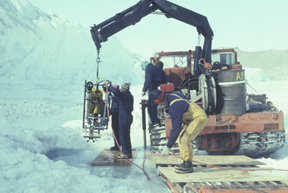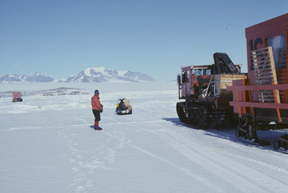 ANDRILL
is an international program including about 170 scientists from the United States,
New Zealand, Italy and Germany. The program has upgraded a drilling technique
adopted from previous drilling efforts, in which mining drill rigs were modified
for drilling sea ice. With a core recovery rate greater than 95 percent in the
types of materials encountered on the Antarctic continental shelf, this drilling
technology performs significantly better in Antarctic locations than other techniques
used by the Ocean Drilling Program farther offshore on the continental slope
and other locations.
ANDRILL
is an international program including about 170 scientists from the United States,
New Zealand, Italy and Germany. The program has upgraded a drilling technique
adopted from previous drilling efforts, in which mining drill rigs were modified
for drilling sea ice. With a core recovery rate greater than 95 percent in the
types of materials encountered on the Antarctic continental shelf, this drilling
technology performs significantly better in Antarctic locations than other techniques
used by the Ocean Drilling Program farther offshore on the continental slope
and other locations. Researchers deploy a remotely operated vehicle (ROV) through sea ice in the southwestern Ross Sea to investigate the chemistry of the chilly waters. Image courtesy of Ross Powell.
ANDRILL’s new drilling rig successfully passed a recent drill test in New Zealand after being customized to work from both sea ice and ice shelves in Antarctica. The rig can lower 2,000 meters of drill string through holes in the ice. For ice shelves, a custom-designed hot water drilling system first melts an access hole through the ice and then the geological drill string is lowered through it. This technology enables the collection of paleo-ice-sheet and paleoclimate records from areas that otherwise are inaccessible.
Two projects within ANDRILL aim to recover records from different geological time periods and thus address slightly different scientific questions. The McMurdo Ice Shelf Project will begin drilling this October and will last approximately two months. The Southern McMurdo Sound Project will start one year later, and both projects are located near the U.S.-operated McMurdo Station and New Zealand-operated Scott Base.
The McMurdo Ice Shelf Project will look at past responses of the floating Ross Ice Shelf and grounded West Antarctic Ice Sheet to a range of climate forcings over various timescales, as environments have changed with the growth or decay of the ice sheet over the past 5 to 10 million years. To reach this goal, ANDRILL will drill into a 1,200-meter-thick body of Pliocene-Pleistocene glacial, marine and volcanic sediments that are rich in remains of fossilized marine life. The sediments have accumulated in the Windless Bight region within a trough around the still-active volcanoes forming Ross Island. The trough in Earth’s oceanic crust around the island has formed over the past several million years as the volcanoes grew in size and locally weighed down the crust.
The project will recover a single 1,000-meter drill core from the trough’s axis in approximately 900 meters of water. Sediments recovered from this core will be used to determine when the site was open water, or when it was covered by sea ice, the Ross Ice Shelf or the West Antarctic Ice Sheet. At present, scientists have little direct evidence of changes through time for this part of the Antarctic Ice Sheet, which some believe is potentially quite sensitive to climatic and sea-level changes.
In contrast, the Southern McMurdo Sound Project is targeting middle Miocene to Pliocene deposits with some thinner younger deposits (approximately 17 million years ago to present), which accumulated in a sinking tectonic basin generated by faulting on the margin of the Victoria Land Basin in the western Ross Sea. The project is primarily trying to establish a robust history of growth and decay of the East Antarctic Ice Sheet and associated sea-ice changes during the Neogene from about 17 million years ago up to about 2 million years ago.
Currently, scientists have windows of time in which they know what has happened with this part of the Antarctic Ice Sheet, from the preserved sediments recovered from previous drilling efforts. The new drilling will hopefully fill some of the critical time gaps when the history of the ice sheet is not well-defined or known at all. The project may also shed more light on the debates about how active the East Antarctic Ice Sheet has been in the past. Understanding such past behavior can help scientists understand how the Antarctic Ice Sheet may behave during current and future global warming.

 Antarctica
truly is “the polar continent,” as it has resided over or near the South
Pole since Gondwanan supercontinent times about 350 million years ago.
Antarctica
truly is “the polar continent,” as it has resided over or near the South
Pole since Gondwanan supercontinent times about 350 million years ago. 